Social Determinants and Social Imagination: Aboriginal Women's Health
VerifiedAdded on 2023/06/03
|12
|3301
|50
Essay
AI Summary
This essay investigates the influence of social determinants and social imagination frameworks on the health of pregnant Aboriginal women who smoke. It examines how factors like income, education, employment, and transport, along with historical and cultural contexts, affect their well-being. The essay highlights the impact of smoking during pregnancy, the role of traditional medicine, and the challenges faced by indigenous communities. It also explores the importance of culturally sensitive healthcare, education, and policy changes to address health disparities. The author reflects on their understanding of these frameworks and suggests potential solutions, including universal income policies, improved education, job opportunities, and accessible healthcare services. The paper emphasizes the need for social inclusion, addressing historical injustices, and incorporating Aboriginal beliefs into treatment methods to improve the health outcomes of pregnant Aboriginal women.

Running head: SOCIAL DETERMINANTS OF HEALTH 1
Social Determinants and Social Imagination among the Pregnant Aboriginal Women who Smoke
Student’s Name
Institutional Affiliation
Social Determinants and Social Imagination among the Pregnant Aboriginal Women who Smoke
Student’s Name
Institutional Affiliation
Paraphrase This Document
Need a fresh take? Get an instant paraphrase of this document with our AI Paraphraser
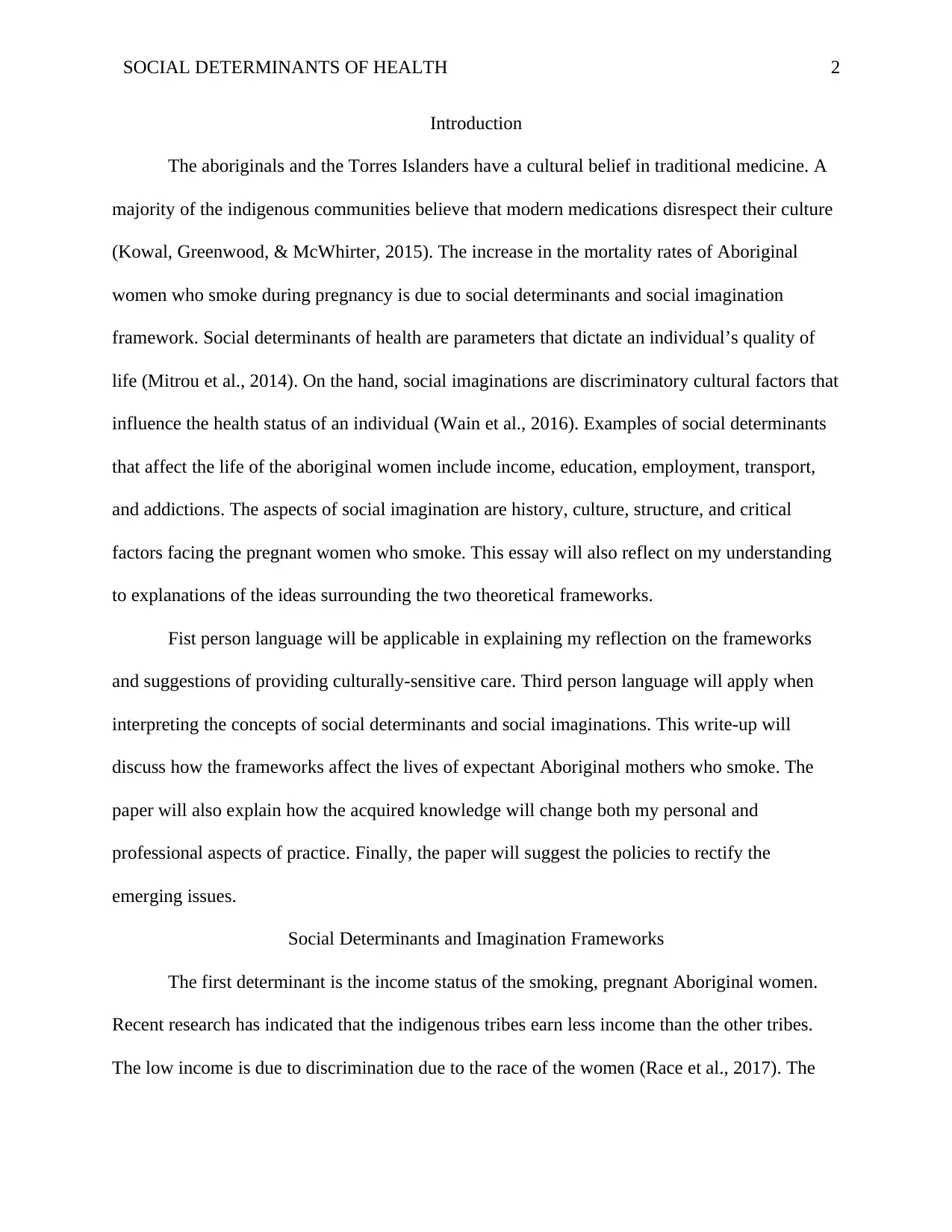
SOCIAL DETERMINANTS OF HEALTH 2
Introduction
The aboriginals and the Torres Islanders have a cultural belief in traditional medicine. A
majority of the indigenous communities believe that modern medications disrespect their culture
(Kowal, Greenwood, & McWhirter, 2015). The increase in the mortality rates of Aboriginal
women who smoke during pregnancy is due to social determinants and social imagination
framework. Social determinants of health are parameters that dictate an individual’s quality of
life (Mitrou et al., 2014). On the hand, social imaginations are discriminatory cultural factors that
influence the health status of an individual (Wain et al., 2016). Examples of social determinants
that affect the life of the aboriginal women include income, education, employment, transport,
and addictions. The aspects of social imagination are history, culture, structure, and critical
factors facing the pregnant women who smoke. This essay will also reflect on my understanding
to explanations of the ideas surrounding the two theoretical frameworks.
Fist person language will be applicable in explaining my reflection on the frameworks
and suggestions of providing culturally-sensitive care. Third person language will apply when
interpreting the concepts of social determinants and social imaginations. This write-up will
discuss how the frameworks affect the lives of expectant Aboriginal mothers who smoke. The
paper will also explain how the acquired knowledge will change both my personal and
professional aspects of practice. Finally, the paper will suggest the policies to rectify the
emerging issues.
Social Determinants and Imagination Frameworks
The first determinant is the income status of the smoking, pregnant Aboriginal women.
Recent research has indicated that the indigenous tribes earn less income than the other tribes.
The low income is due to discrimination due to the race of the women (Race et al., 2017). The
Introduction
The aboriginals and the Torres Islanders have a cultural belief in traditional medicine. A
majority of the indigenous communities believe that modern medications disrespect their culture
(Kowal, Greenwood, & McWhirter, 2015). The increase in the mortality rates of Aboriginal
women who smoke during pregnancy is due to social determinants and social imagination
framework. Social determinants of health are parameters that dictate an individual’s quality of
life (Mitrou et al., 2014). On the hand, social imaginations are discriminatory cultural factors that
influence the health status of an individual (Wain et al., 2016). Examples of social determinants
that affect the life of the aboriginal women include income, education, employment, transport,
and addictions. The aspects of social imagination are history, culture, structure, and critical
factors facing the pregnant women who smoke. This essay will also reflect on my understanding
to explanations of the ideas surrounding the two theoretical frameworks.
Fist person language will be applicable in explaining my reflection on the frameworks
and suggestions of providing culturally-sensitive care. Third person language will apply when
interpreting the concepts of social determinants and social imaginations. This write-up will
discuss how the frameworks affect the lives of expectant Aboriginal mothers who smoke. The
paper will also explain how the acquired knowledge will change both my personal and
professional aspects of practice. Finally, the paper will suggest the policies to rectify the
emerging issues.
Social Determinants and Imagination Frameworks
The first determinant is the income status of the smoking, pregnant Aboriginal women.
Recent research has indicated that the indigenous tribes earn less income than the other tribes.
The low income is due to discrimination due to the race of the women (Race et al., 2017). The
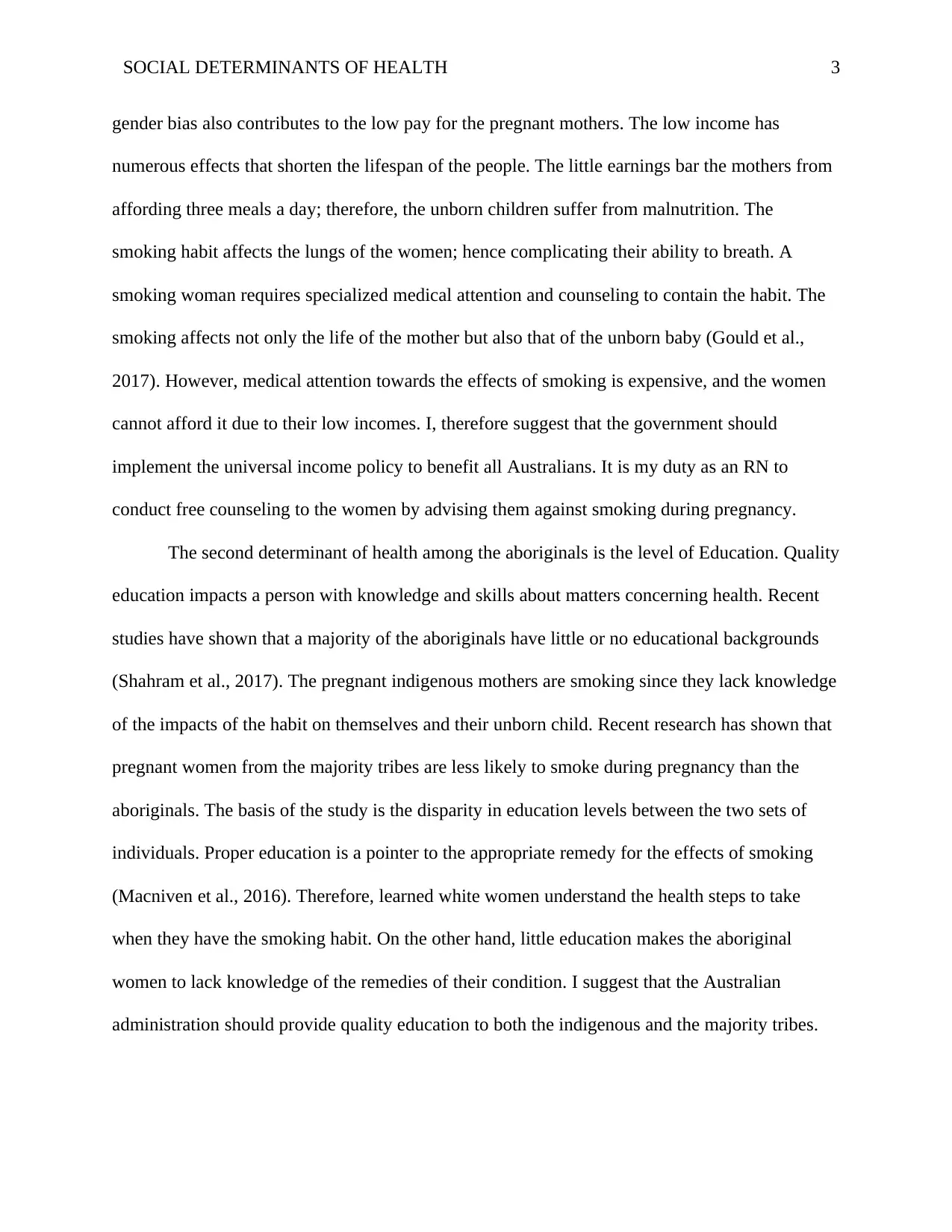
SOCIAL DETERMINANTS OF HEALTH 3
gender bias also contributes to the low pay for the pregnant mothers. The low income has
numerous effects that shorten the lifespan of the people. The little earnings bar the mothers from
affording three meals a day; therefore, the unborn children suffer from malnutrition. The
smoking habit affects the lungs of the women; hence complicating their ability to breath. A
smoking woman requires specialized medical attention and counseling to contain the habit. The
smoking affects not only the life of the mother but also that of the unborn baby (Gould et al.,
2017). However, medical attention towards the effects of smoking is expensive, and the women
cannot afford it due to their low incomes. I, therefore suggest that the government should
implement the universal income policy to benefit all Australians. It is my duty as an RN to
conduct free counseling to the women by advising them against smoking during pregnancy.
The second determinant of health among the aboriginals is the level of Education. Quality
education impacts a person with knowledge and skills about matters concerning health. Recent
studies have shown that a majority of the aboriginals have little or no educational backgrounds
(Shahram et al., 2017). The pregnant indigenous mothers are smoking since they lack knowledge
of the impacts of the habit on themselves and their unborn child. Recent research has shown that
pregnant women from the majority tribes are less likely to smoke during pregnancy than the
aboriginals. The basis of the study is the disparity in education levels between the two sets of
individuals. Proper education is a pointer to the appropriate remedy for the effects of smoking
(Macniven et al., 2016). Therefore, learned white women understand the health steps to take
when they have the smoking habit. On the other hand, little education makes the aboriginal
women to lack knowledge of the remedies of their condition. I suggest that the Australian
administration should provide quality education to both the indigenous and the majority tribes.
gender bias also contributes to the low pay for the pregnant mothers. The low income has
numerous effects that shorten the lifespan of the people. The little earnings bar the mothers from
affording three meals a day; therefore, the unborn children suffer from malnutrition. The
smoking habit affects the lungs of the women; hence complicating their ability to breath. A
smoking woman requires specialized medical attention and counseling to contain the habit. The
smoking affects not only the life of the mother but also that of the unborn baby (Gould et al.,
2017). However, medical attention towards the effects of smoking is expensive, and the women
cannot afford it due to their low incomes. I, therefore suggest that the government should
implement the universal income policy to benefit all Australians. It is my duty as an RN to
conduct free counseling to the women by advising them against smoking during pregnancy.
The second determinant of health among the aboriginals is the level of Education. Quality
education impacts a person with knowledge and skills about matters concerning health. Recent
studies have shown that a majority of the aboriginals have little or no educational backgrounds
(Shahram et al., 2017). The pregnant indigenous mothers are smoking since they lack knowledge
of the impacts of the habit on themselves and their unborn child. Recent research has shown that
pregnant women from the majority tribes are less likely to smoke during pregnancy than the
aboriginals. The basis of the study is the disparity in education levels between the two sets of
individuals. Proper education is a pointer to the appropriate remedy for the effects of smoking
(Macniven et al., 2016). Therefore, learned white women understand the health steps to take
when they have the smoking habit. On the other hand, little education makes the aboriginal
women to lack knowledge of the remedies of their condition. I suggest that the Australian
administration should provide quality education to both the indigenous and the majority tribes.
⊘ This is a preview!⊘
Do you want full access?
Subscribe today to unlock all pages.

Trusted by 1+ million students worldwide
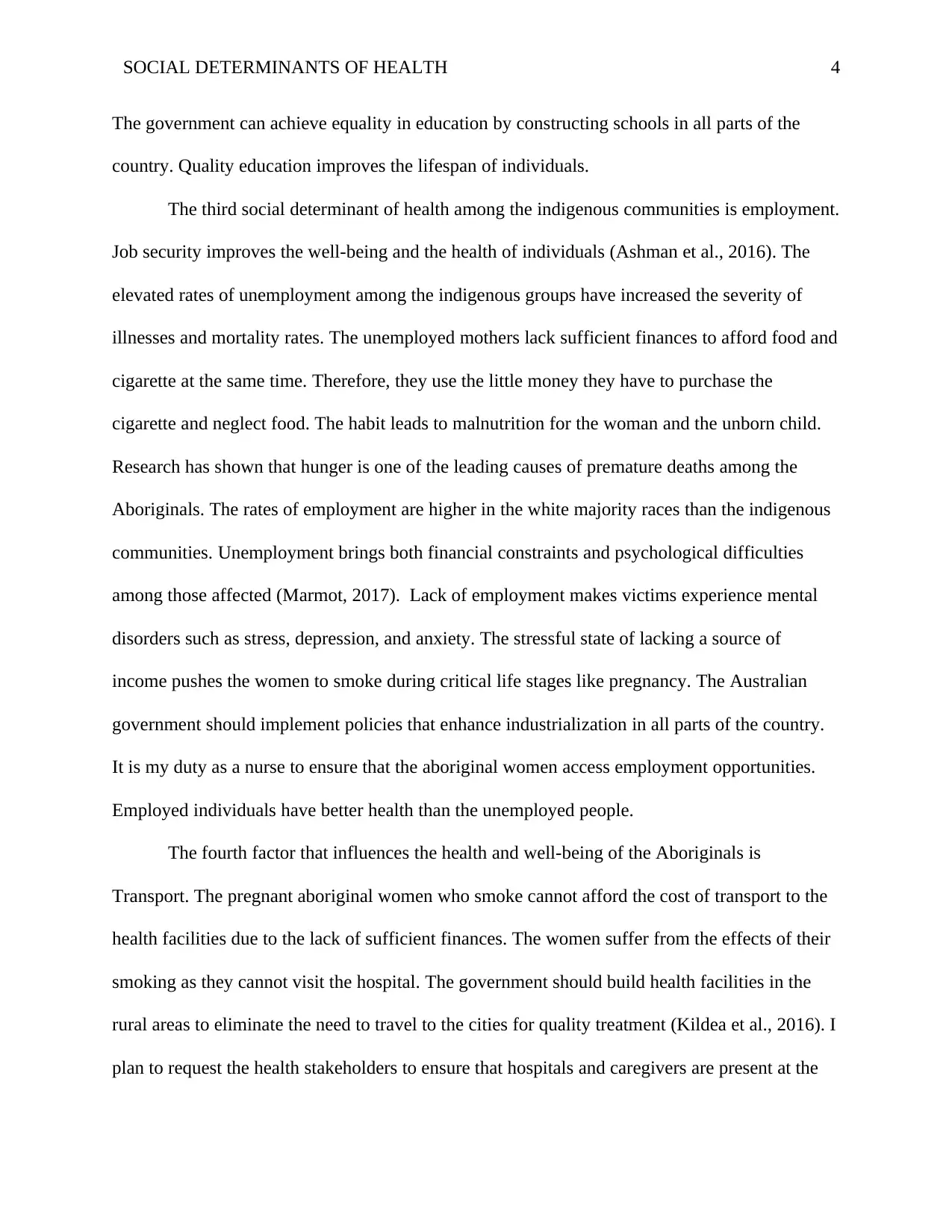
SOCIAL DETERMINANTS OF HEALTH 4
The government can achieve equality in education by constructing schools in all parts of the
country. Quality education improves the lifespan of individuals.
The third social determinant of health among the indigenous communities is employment.
Job security improves the well-being and the health of individuals (Ashman et al., 2016). The
elevated rates of unemployment among the indigenous groups have increased the severity of
illnesses and mortality rates. The unemployed mothers lack sufficient finances to afford food and
cigarette at the same time. Therefore, they use the little money they have to purchase the
cigarette and neglect food. The habit leads to malnutrition for the woman and the unborn child.
Research has shown that hunger is one of the leading causes of premature deaths among the
Aboriginals. The rates of employment are higher in the white majority races than the indigenous
communities. Unemployment brings both financial constraints and psychological difficulties
among those affected (Marmot, 2017). Lack of employment makes victims experience mental
disorders such as stress, depression, and anxiety. The stressful state of lacking a source of
income pushes the women to smoke during critical life stages like pregnancy. The Australian
government should implement policies that enhance industrialization in all parts of the country.
It is my duty as a nurse to ensure that the aboriginal women access employment opportunities.
Employed individuals have better health than the unemployed people.
The fourth factor that influences the health and well-being of the Aboriginals is
Transport. The pregnant aboriginal women who smoke cannot afford the cost of transport to the
health facilities due to the lack of sufficient finances. The women suffer from the effects of their
smoking as they cannot visit the hospital. The government should build health facilities in the
rural areas to eliminate the need to travel to the cities for quality treatment (Kildea et al., 2016). I
plan to request the health stakeholders to ensure that hospitals and caregivers are present at the
The government can achieve equality in education by constructing schools in all parts of the
country. Quality education improves the lifespan of individuals.
The third social determinant of health among the indigenous communities is employment.
Job security improves the well-being and the health of individuals (Ashman et al., 2016). The
elevated rates of unemployment among the indigenous groups have increased the severity of
illnesses and mortality rates. The unemployed mothers lack sufficient finances to afford food and
cigarette at the same time. Therefore, they use the little money they have to purchase the
cigarette and neglect food. The habit leads to malnutrition for the woman and the unborn child.
Research has shown that hunger is one of the leading causes of premature deaths among the
Aboriginals. The rates of employment are higher in the white majority races than the indigenous
communities. Unemployment brings both financial constraints and psychological difficulties
among those affected (Marmot, 2017). Lack of employment makes victims experience mental
disorders such as stress, depression, and anxiety. The stressful state of lacking a source of
income pushes the women to smoke during critical life stages like pregnancy. The Australian
government should implement policies that enhance industrialization in all parts of the country.
It is my duty as a nurse to ensure that the aboriginal women access employment opportunities.
Employed individuals have better health than the unemployed people.
The fourth factor that influences the health and well-being of the Aboriginals is
Transport. The pregnant aboriginal women who smoke cannot afford the cost of transport to the
health facilities due to the lack of sufficient finances. The women suffer from the effects of their
smoking as they cannot visit the hospital. The government should build health facilities in the
rural areas to eliminate the need to travel to the cities for quality treatment (Kildea et al., 2016). I
plan to request the health stakeholders to ensure that hospitals and caregivers are present at the
Paraphrase This Document
Need a fresh take? Get an instant paraphrase of this document with our AI Paraphraser
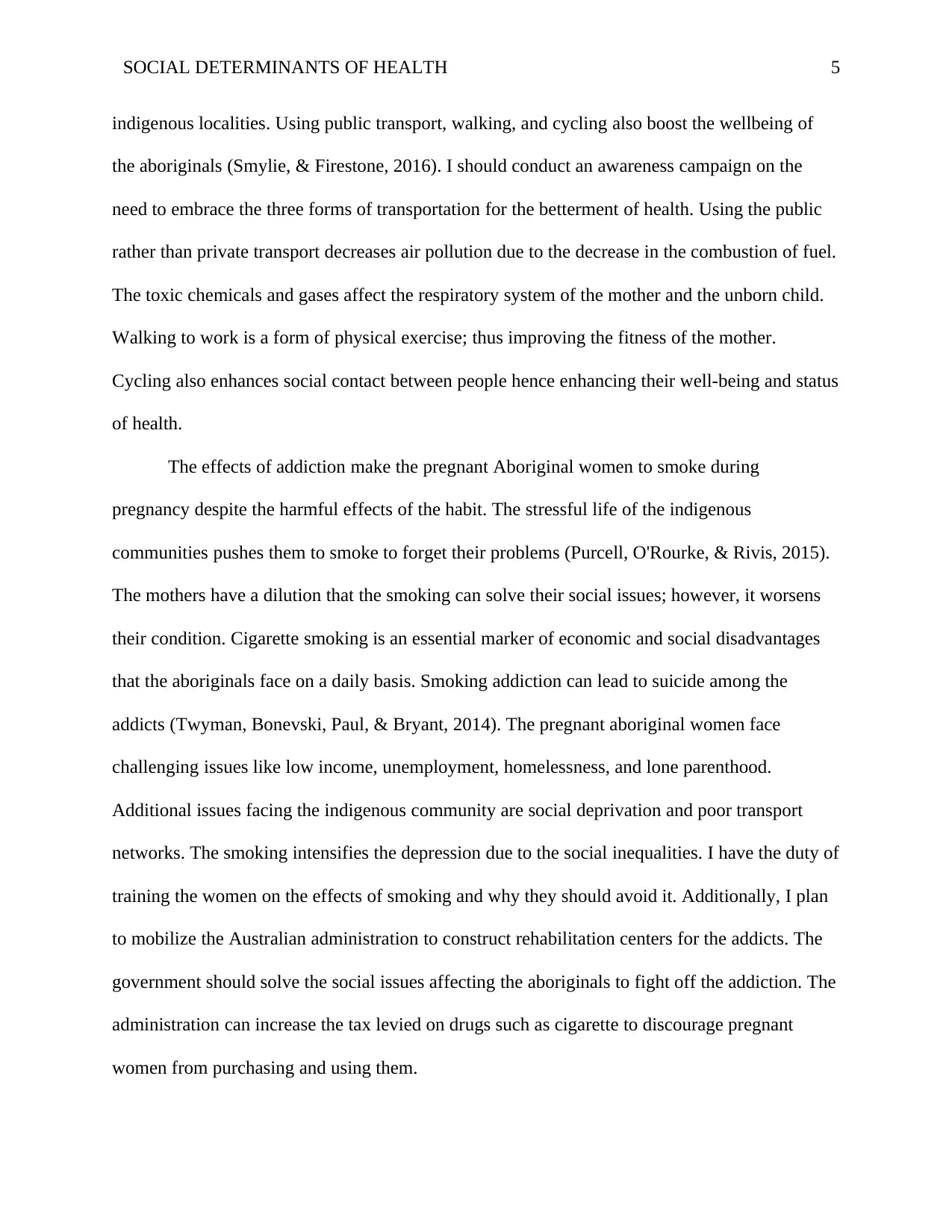
SOCIAL DETERMINANTS OF HEALTH 5
indigenous localities. Using public transport, walking, and cycling also boost the wellbeing of
the aboriginals (Smylie, & Firestone, 2016). I should conduct an awareness campaign on the
need to embrace the three forms of transportation for the betterment of health. Using the public
rather than private transport decreases air pollution due to the decrease in the combustion of fuel.
The toxic chemicals and gases affect the respiratory system of the mother and the unborn child.
Walking to work is a form of physical exercise; thus improving the fitness of the mother.
Cycling also enhances social contact between people hence enhancing their well-being and status
of health.
The effects of addiction make the pregnant Aboriginal women to smoke during
pregnancy despite the harmful effects of the habit. The stressful life of the indigenous
communities pushes them to smoke to forget their problems (Purcell, O'Rourke, & Rivis, 2015).
The mothers have a dilution that the smoking can solve their social issues; however, it worsens
their condition. Cigarette smoking is an essential marker of economic and social disadvantages
that the aboriginals face on a daily basis. Smoking addiction can lead to suicide among the
addicts (Twyman, Bonevski, Paul, & Bryant, 2014). The pregnant aboriginal women face
challenging issues like low income, unemployment, homelessness, and lone parenthood.
Additional issues facing the indigenous community are social deprivation and poor transport
networks. The smoking intensifies the depression due to the social inequalities. I have the duty of
training the women on the effects of smoking and why they should avoid it. Additionally, I plan
to mobilize the Australian administration to construct rehabilitation centers for the addicts. The
government should solve the social issues affecting the aboriginals to fight off the addiction. The
administration can increase the tax levied on drugs such as cigarette to discourage pregnant
women from purchasing and using them.
indigenous localities. Using public transport, walking, and cycling also boost the wellbeing of
the aboriginals (Smylie, & Firestone, 2016). I should conduct an awareness campaign on the
need to embrace the three forms of transportation for the betterment of health. Using the public
rather than private transport decreases air pollution due to the decrease in the combustion of fuel.
The toxic chemicals and gases affect the respiratory system of the mother and the unborn child.
Walking to work is a form of physical exercise; thus improving the fitness of the mother.
Cycling also enhances social contact between people hence enhancing their well-being and status
of health.
The effects of addiction make the pregnant Aboriginal women to smoke during
pregnancy despite the harmful effects of the habit. The stressful life of the indigenous
communities pushes them to smoke to forget their problems (Purcell, O'Rourke, & Rivis, 2015).
The mothers have a dilution that the smoking can solve their social issues; however, it worsens
their condition. Cigarette smoking is an essential marker of economic and social disadvantages
that the aboriginals face on a daily basis. Smoking addiction can lead to suicide among the
addicts (Twyman, Bonevski, Paul, & Bryant, 2014). The pregnant aboriginal women face
challenging issues like low income, unemployment, homelessness, and lone parenthood.
Additional issues facing the indigenous community are social deprivation and poor transport
networks. The smoking intensifies the depression due to the social inequalities. I have the duty of
training the women on the effects of smoking and why they should avoid it. Additionally, I plan
to mobilize the Australian administration to construct rehabilitation centers for the addicts. The
government should solve the social issues affecting the aboriginals to fight off the addiction. The
administration can increase the tax levied on drugs such as cigarette to discourage pregnant
women from purchasing and using them.

SOCIAL DETERMINANTS OF HEALTH 6
Aspects of social imagination also influence the health of the pregnant aboriginal women
who smoke. The first aspect of social creativity is the historical backgrounds and beliefs of the
indigenous community (Dudgeon, & Walker, 2015). Since time immemorial, the rest of
Australian tribes have alienated the aboriginals. The alienation has made the indigenous
individuals have limited access to essential health facilities like the rest. The minority tribes also
have negative histories of unemployment, low income, and other unfavorable conditions. The
government should acknowledge the historical differences between the different Australian tribes
(Paradies, 2016). The administration should also enact policies that accommodate the heritage of
the aboriginals. I plan to ask the health stakeholders to attend to the health concerns of the
indigenous groups. Health facilities should incorporate the beliefs of the aboriginals in the
treatment methods. The women have a history of smoking when pregnant. Therefore, the health
organizations should conduct public awareness on the dangers of smoking. The government
should also correct the historical injustices such as high unemployment rates for the people. The
administration should encourage industrialization to create employment opportunities for the
women. The department of housing should construct proper houses for the aboriginals to
eliminate the stress due to lack of shelter.
Culture is another social imagination that affects the health of the pregnant aboriginal
women who smoke a cigarette. Culture is a collective term for the beliefs of a given community.
The aspect of social imagination dictates how a specific group of individuals undertake their
daily activities. The majority of the aboriginals believe that the modern methods of treatment are
contrary to their beliefs (Pockett, & Beddoe, 2017). The Aboriginals believe in the healing power
of the traditional medicines which the modern health facilities do not apply during medical
attention. However, the traditional drugs have numerous limitations; hence endangering the lives
Aspects of social imagination also influence the health of the pregnant aboriginal women
who smoke. The first aspect of social creativity is the historical backgrounds and beliefs of the
indigenous community (Dudgeon, & Walker, 2015). Since time immemorial, the rest of
Australian tribes have alienated the aboriginals. The alienation has made the indigenous
individuals have limited access to essential health facilities like the rest. The minority tribes also
have negative histories of unemployment, low income, and other unfavorable conditions. The
government should acknowledge the historical differences between the different Australian tribes
(Paradies, 2016). The administration should also enact policies that accommodate the heritage of
the aboriginals. I plan to ask the health stakeholders to attend to the health concerns of the
indigenous groups. Health facilities should incorporate the beliefs of the aboriginals in the
treatment methods. The women have a history of smoking when pregnant. Therefore, the health
organizations should conduct public awareness on the dangers of smoking. The government
should also correct the historical injustices such as high unemployment rates for the people. The
administration should encourage industrialization to create employment opportunities for the
women. The department of housing should construct proper houses for the aboriginals to
eliminate the stress due to lack of shelter.
Culture is another social imagination that affects the health of the pregnant aboriginal
women who smoke a cigarette. Culture is a collective term for the beliefs of a given community.
The aspect of social imagination dictates how a specific group of individuals undertake their
daily activities. The majority of the aboriginals believe that the modern methods of treatment are
contrary to their beliefs (Pockett, & Beddoe, 2017). The Aboriginals believe in the healing power
of the traditional medicines which the modern health facilities do not apply during medical
attention. However, the traditional drugs have numerous limitations; hence endangering the lives
⊘ This is a preview!⊘
Do you want full access?
Subscribe today to unlock all pages.

Trusted by 1+ million students worldwide
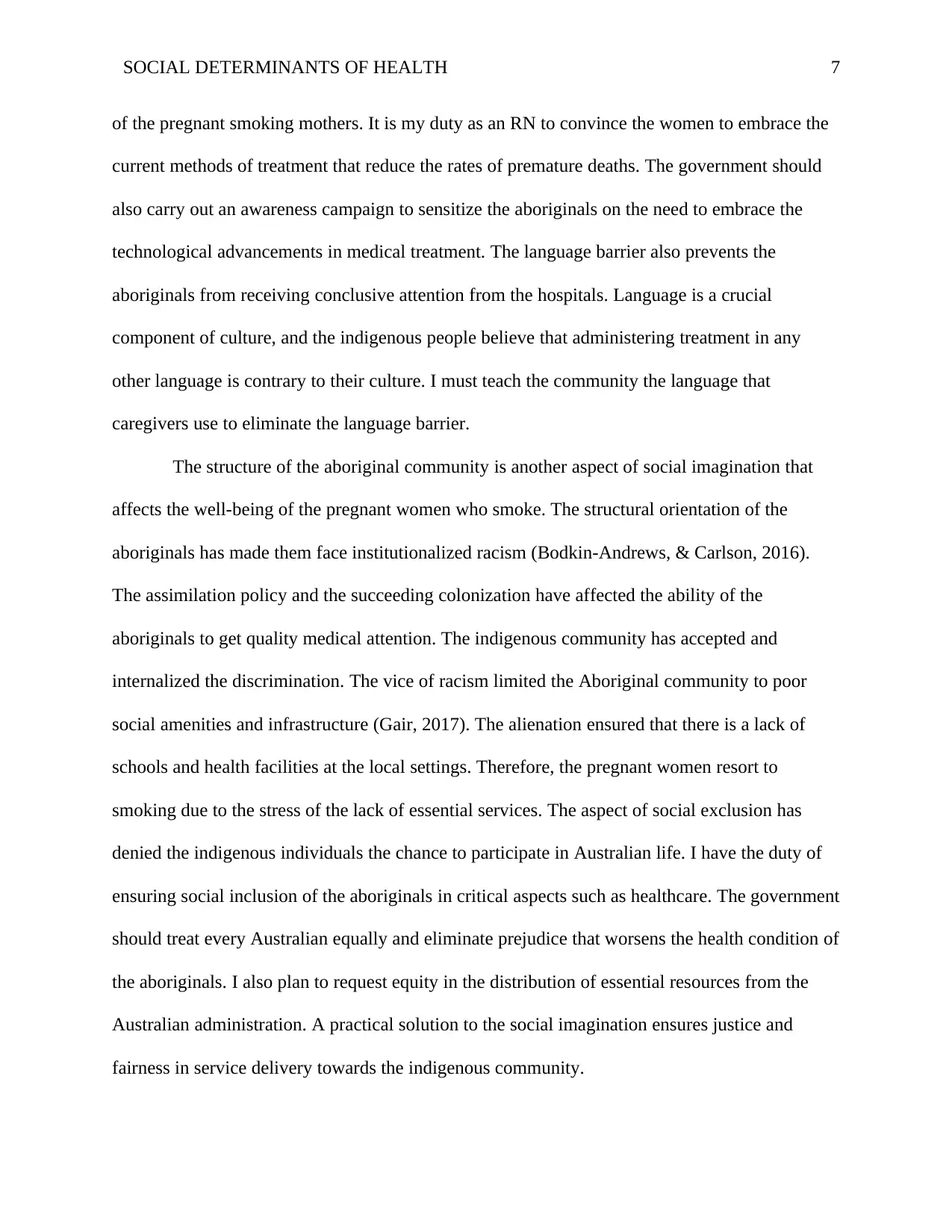
SOCIAL DETERMINANTS OF HEALTH 7
of the pregnant smoking mothers. It is my duty as an RN to convince the women to embrace the
current methods of treatment that reduce the rates of premature deaths. The government should
also carry out an awareness campaign to sensitize the aboriginals on the need to embrace the
technological advancements in medical treatment. The language barrier also prevents the
aboriginals from receiving conclusive attention from the hospitals. Language is a crucial
component of culture, and the indigenous people believe that administering treatment in any
other language is contrary to their culture. I must teach the community the language that
caregivers use to eliminate the language barrier.
The structure of the aboriginal community is another aspect of social imagination that
affects the well-being of the pregnant women who smoke. The structural orientation of the
aboriginals has made them face institutionalized racism (Bodkin-Andrews, & Carlson, 2016).
The assimilation policy and the succeeding colonization have affected the ability of the
aboriginals to get quality medical attention. The indigenous community has accepted and
internalized the discrimination. The vice of racism limited the Aboriginal community to poor
social amenities and infrastructure (Gair, 2017). The alienation ensured that there is a lack of
schools and health facilities at the local settings. Therefore, the pregnant women resort to
smoking due to the stress of the lack of essential services. The aspect of social exclusion has
denied the indigenous individuals the chance to participate in Australian life. I have the duty of
ensuring social inclusion of the aboriginals in critical aspects such as healthcare. The government
should treat every Australian equally and eliminate prejudice that worsens the health condition of
the aboriginals. I also plan to request equity in the distribution of essential resources from the
Australian administration. A practical solution to the social imagination ensures justice and
fairness in service delivery towards the indigenous community.
of the pregnant smoking mothers. It is my duty as an RN to convince the women to embrace the
current methods of treatment that reduce the rates of premature deaths. The government should
also carry out an awareness campaign to sensitize the aboriginals on the need to embrace the
technological advancements in medical treatment. The language barrier also prevents the
aboriginals from receiving conclusive attention from the hospitals. Language is a crucial
component of culture, and the indigenous people believe that administering treatment in any
other language is contrary to their culture. I must teach the community the language that
caregivers use to eliminate the language barrier.
The structure of the aboriginal community is another aspect of social imagination that
affects the well-being of the pregnant women who smoke. The structural orientation of the
aboriginals has made them face institutionalized racism (Bodkin-Andrews, & Carlson, 2016).
The assimilation policy and the succeeding colonization have affected the ability of the
aboriginals to get quality medical attention. The indigenous community has accepted and
internalized the discrimination. The vice of racism limited the Aboriginal community to poor
social amenities and infrastructure (Gair, 2017). The alienation ensured that there is a lack of
schools and health facilities at the local settings. Therefore, the pregnant women resort to
smoking due to the stress of the lack of essential services. The aspect of social exclusion has
denied the indigenous individuals the chance to participate in Australian life. I have the duty of
ensuring social inclusion of the aboriginals in critical aspects such as healthcare. The government
should treat every Australian equally and eliminate prejudice that worsens the health condition of
the aboriginals. I also plan to request equity in the distribution of essential resources from the
Australian administration. A practical solution to the social imagination ensures justice and
fairness in service delivery towards the indigenous community.
Paraphrase This Document
Need a fresh take? Get an instant paraphrase of this document with our AI Paraphraser
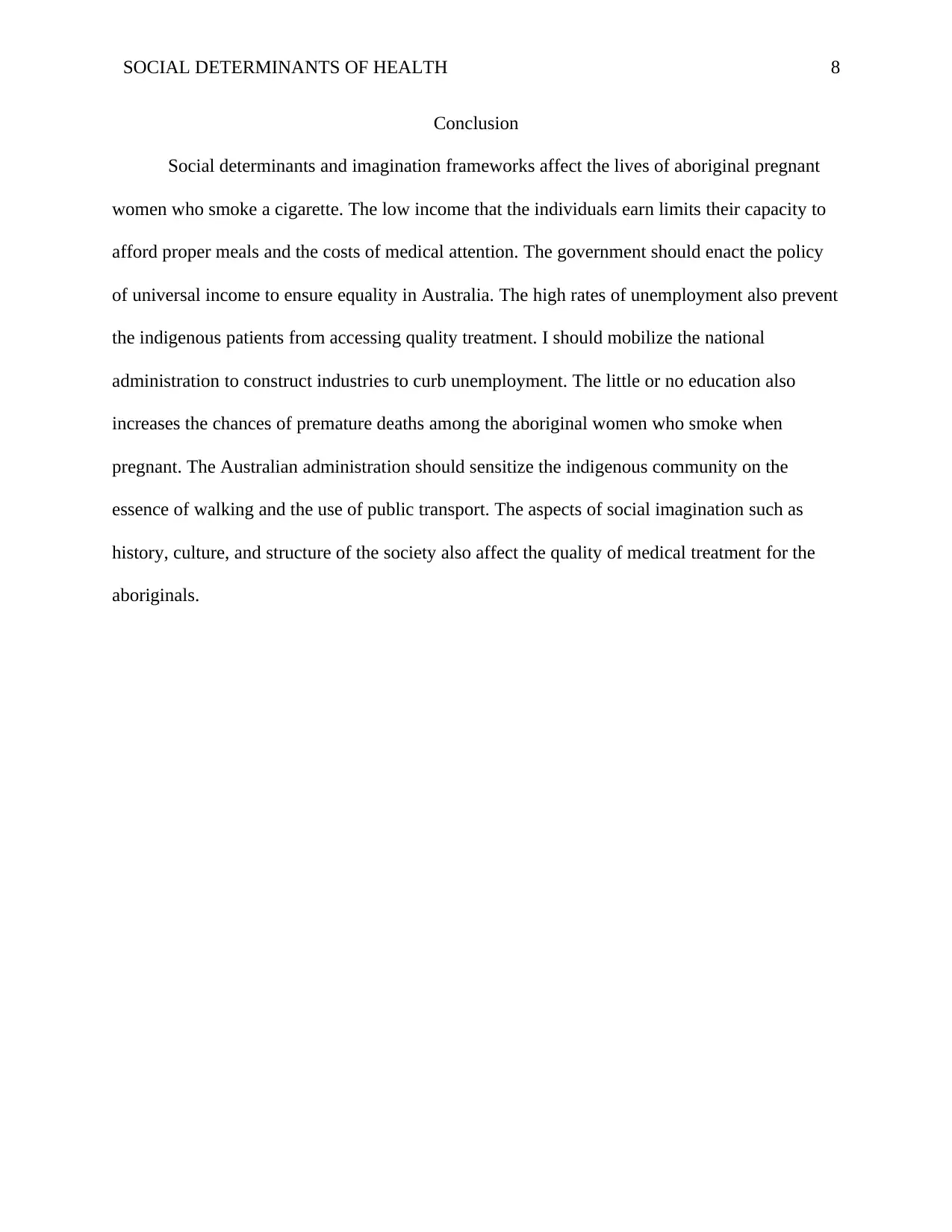
SOCIAL DETERMINANTS OF HEALTH 8
Conclusion
Social determinants and imagination frameworks affect the lives of aboriginal pregnant
women who smoke a cigarette. The low income that the individuals earn limits their capacity to
afford proper meals and the costs of medical attention. The government should enact the policy
of universal income to ensure equality in Australia. The high rates of unemployment also prevent
the indigenous patients from accessing quality treatment. I should mobilize the national
administration to construct industries to curb unemployment. The little or no education also
increases the chances of premature deaths among the aboriginal women who smoke when
pregnant. The Australian administration should sensitize the indigenous community on the
essence of walking and the use of public transport. The aspects of social imagination such as
history, culture, and structure of the society also affect the quality of medical treatment for the
aboriginals.
Conclusion
Social determinants and imagination frameworks affect the lives of aboriginal pregnant
women who smoke a cigarette. The low income that the individuals earn limits their capacity to
afford proper meals and the costs of medical attention. The government should enact the policy
of universal income to ensure equality in Australia. The high rates of unemployment also prevent
the indigenous patients from accessing quality treatment. I should mobilize the national
administration to construct industries to curb unemployment. The little or no education also
increases the chances of premature deaths among the aboriginal women who smoke when
pregnant. The Australian administration should sensitize the indigenous community on the
essence of walking and the use of public transport. The aspects of social imagination such as
history, culture, and structure of the society also affect the quality of medical treatment for the
aboriginals.
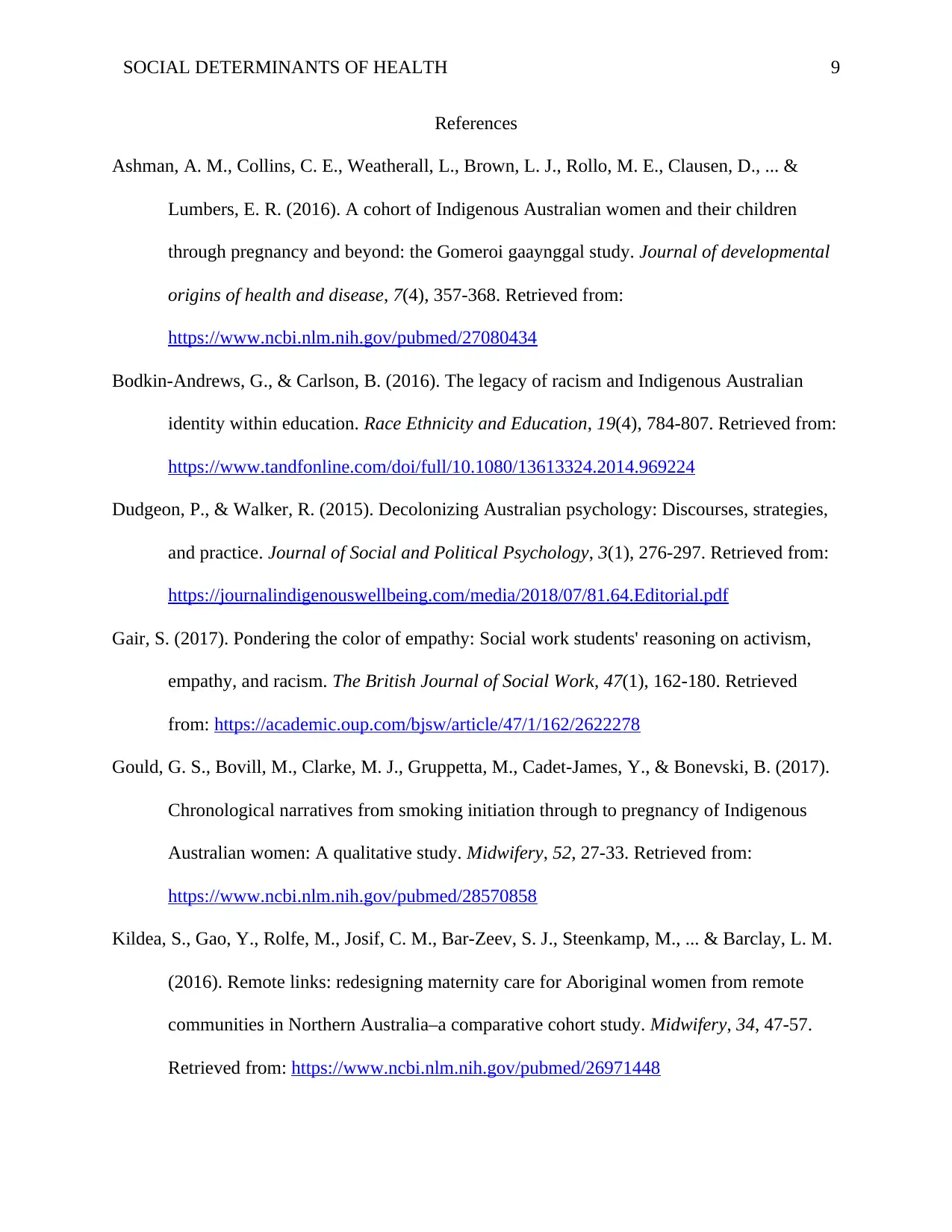
SOCIAL DETERMINANTS OF HEALTH 9
References
Ashman, A. M., Collins, C. E., Weatherall, L., Brown, L. J., Rollo, M. E., Clausen, D., ... &
Lumbers, E. R. (2016). A cohort of Indigenous Australian women and their children
through pregnancy and beyond: the Gomeroi gaaynggal study. Journal of developmental
origins of health and disease, 7(4), 357-368. Retrieved from:
https://www.ncbi.nlm.nih.gov/pubmed/27080434
Bodkin-Andrews, G., & Carlson, B. (2016). The legacy of racism and Indigenous Australian
identity within education. Race Ethnicity and Education, 19(4), 784-807. Retrieved from:
https://www.tandfonline.com/doi/full/10.1080/13613324.2014.969224
Dudgeon, P., & Walker, R. (2015). Decolonizing Australian psychology: Discourses, strategies,
and practice. Journal of Social and Political Psychology, 3(1), 276-297. Retrieved from:
https://journalindigenouswellbeing.com/media/2018/07/81.64.Editorial.pdf
Gair, S. (2017). Pondering the color of empathy: Social work students' reasoning on activism,
empathy, and racism. The British Journal of Social Work, 47(1), 162-180. Retrieved
from: https://academic.oup.com/bjsw/article/47/1/162/2622278
Gould, G. S., Bovill, M., Clarke, M. J., Gruppetta, M., Cadet-James, Y., & Bonevski, B. (2017).
Chronological narratives from smoking initiation through to pregnancy of Indigenous
Australian women: A qualitative study. Midwifery, 52, 27-33. Retrieved from:
https://www.ncbi.nlm.nih.gov/pubmed/28570858
Kildea, S., Gao, Y., Rolfe, M., Josif, C. M., Bar-Zeev, S. J., Steenkamp, M., ... & Barclay, L. M.
(2016). Remote links: redesigning maternity care for Aboriginal women from remote
communities in Northern Australia–a comparative cohort study. Midwifery, 34, 47-57.
Retrieved from: https://www.ncbi.nlm.nih.gov/pubmed/26971448
References
Ashman, A. M., Collins, C. E., Weatherall, L., Brown, L. J., Rollo, M. E., Clausen, D., ... &
Lumbers, E. R. (2016). A cohort of Indigenous Australian women and their children
through pregnancy and beyond: the Gomeroi gaaynggal study. Journal of developmental
origins of health and disease, 7(4), 357-368. Retrieved from:
https://www.ncbi.nlm.nih.gov/pubmed/27080434
Bodkin-Andrews, G., & Carlson, B. (2016). The legacy of racism and Indigenous Australian
identity within education. Race Ethnicity and Education, 19(4), 784-807. Retrieved from:
https://www.tandfonline.com/doi/full/10.1080/13613324.2014.969224
Dudgeon, P., & Walker, R. (2015). Decolonizing Australian psychology: Discourses, strategies,
and practice. Journal of Social and Political Psychology, 3(1), 276-297. Retrieved from:
https://journalindigenouswellbeing.com/media/2018/07/81.64.Editorial.pdf
Gair, S. (2017). Pondering the color of empathy: Social work students' reasoning on activism,
empathy, and racism. The British Journal of Social Work, 47(1), 162-180. Retrieved
from: https://academic.oup.com/bjsw/article/47/1/162/2622278
Gould, G. S., Bovill, M., Clarke, M. J., Gruppetta, M., Cadet-James, Y., & Bonevski, B. (2017).
Chronological narratives from smoking initiation through to pregnancy of Indigenous
Australian women: A qualitative study. Midwifery, 52, 27-33. Retrieved from:
https://www.ncbi.nlm.nih.gov/pubmed/28570858
Kildea, S., Gao, Y., Rolfe, M., Josif, C. M., Bar-Zeev, S. J., Steenkamp, M., ... & Barclay, L. M.
(2016). Remote links: redesigning maternity care for Aboriginal women from remote
communities in Northern Australia–a comparative cohort study. Midwifery, 34, 47-57.
Retrieved from: https://www.ncbi.nlm.nih.gov/pubmed/26971448
⊘ This is a preview!⊘
Do you want full access?
Subscribe today to unlock all pages.

Trusted by 1+ million students worldwide
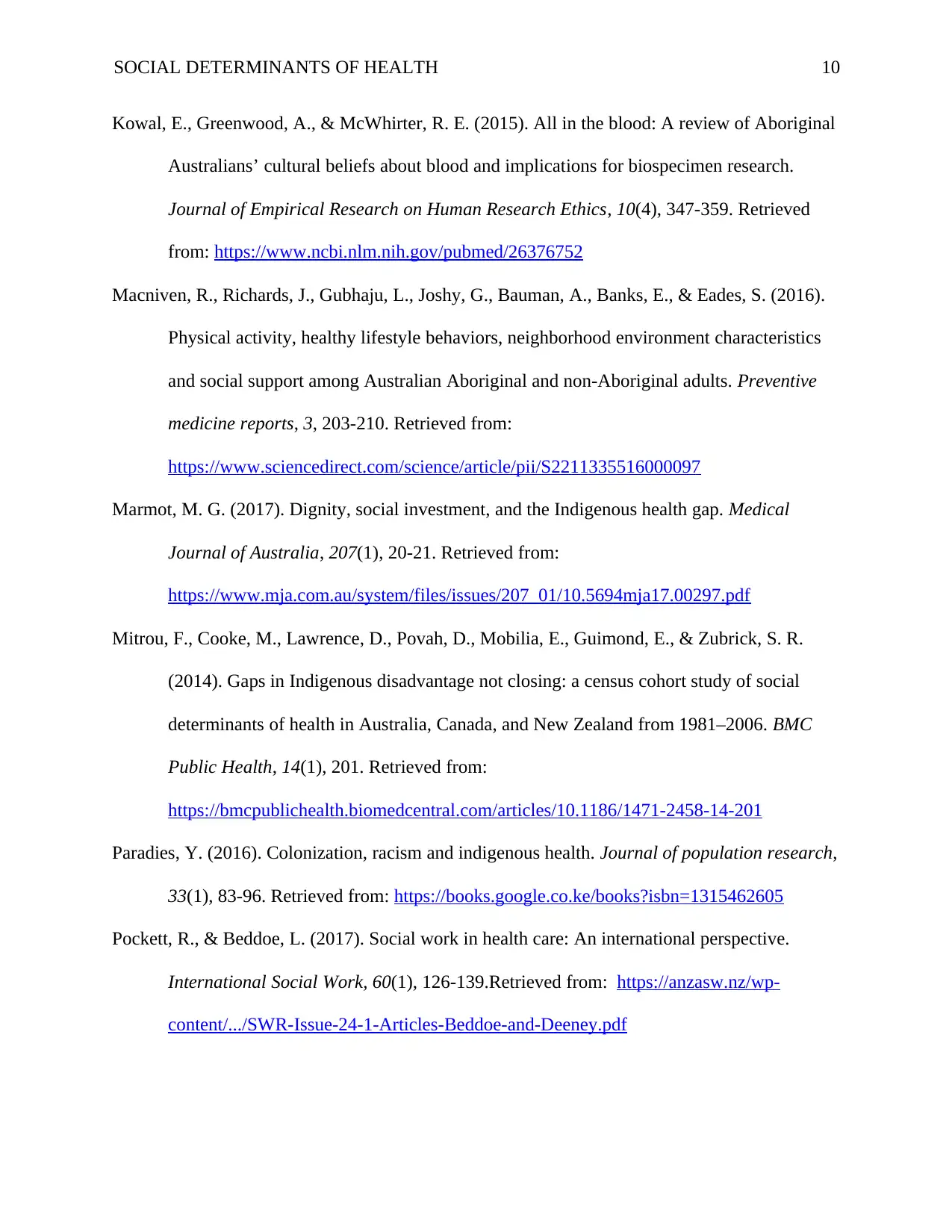
SOCIAL DETERMINANTS OF HEALTH 10
Kowal, E., Greenwood, A., & McWhirter, R. E. (2015). All in the blood: A review of Aboriginal
Australians’ cultural beliefs about blood and implications for biospecimen research.
Journal of Empirical Research on Human Research Ethics, 10(4), 347-359. Retrieved
from: https://www.ncbi.nlm.nih.gov/pubmed/26376752
Macniven, R., Richards, J., Gubhaju, L., Joshy, G., Bauman, A., Banks, E., & Eades, S. (2016).
Physical activity, healthy lifestyle behaviors, neighborhood environment characteristics
and social support among Australian Aboriginal and non-Aboriginal adults. Preventive
medicine reports, 3, 203-210. Retrieved from:
https://www.sciencedirect.com/science/article/pii/S2211335516000097
Marmot, M. G. (2017). Dignity, social investment, and the Indigenous health gap. Medical
Journal of Australia, 207(1), 20-21. Retrieved from:
https://www.mja.com.au/system/files/issues/207_01/10.5694mja17.00297.pdf
Mitrou, F., Cooke, M., Lawrence, D., Povah, D., Mobilia, E., Guimond, E., & Zubrick, S. R.
(2014). Gaps in Indigenous disadvantage not closing: a census cohort study of social
determinants of health in Australia, Canada, and New Zealand from 1981–2006. BMC
Public Health, 14(1), 201. Retrieved from:
https://bmcpublichealth.biomedcentral.com/articles/10.1186/1471-2458-14-201
Paradies, Y. (2016). Colonization, racism and indigenous health. Journal of population research,
33(1), 83-96. Retrieved from: https://books.google.co.ke/books?isbn=1315462605
Pockett, R., & Beddoe, L. (2017). Social work in health care: An international perspective.
International Social Work, 60(1), 126-139.Retrieved from: https://anzasw.nz/wp-
content/.../SWR-Issue-24-1-Articles-Beddoe-and-Deeney.pdf
Kowal, E., Greenwood, A., & McWhirter, R. E. (2015). All in the blood: A review of Aboriginal
Australians’ cultural beliefs about blood and implications for biospecimen research.
Journal of Empirical Research on Human Research Ethics, 10(4), 347-359. Retrieved
from: https://www.ncbi.nlm.nih.gov/pubmed/26376752
Macniven, R., Richards, J., Gubhaju, L., Joshy, G., Bauman, A., Banks, E., & Eades, S. (2016).
Physical activity, healthy lifestyle behaviors, neighborhood environment characteristics
and social support among Australian Aboriginal and non-Aboriginal adults. Preventive
medicine reports, 3, 203-210. Retrieved from:
https://www.sciencedirect.com/science/article/pii/S2211335516000097
Marmot, M. G. (2017). Dignity, social investment, and the Indigenous health gap. Medical
Journal of Australia, 207(1), 20-21. Retrieved from:
https://www.mja.com.au/system/files/issues/207_01/10.5694mja17.00297.pdf
Mitrou, F., Cooke, M., Lawrence, D., Povah, D., Mobilia, E., Guimond, E., & Zubrick, S. R.
(2014). Gaps in Indigenous disadvantage not closing: a census cohort study of social
determinants of health in Australia, Canada, and New Zealand from 1981–2006. BMC
Public Health, 14(1), 201. Retrieved from:
https://bmcpublichealth.biomedcentral.com/articles/10.1186/1471-2458-14-201
Paradies, Y. (2016). Colonization, racism and indigenous health. Journal of population research,
33(1), 83-96. Retrieved from: https://books.google.co.ke/books?isbn=1315462605
Pockett, R., & Beddoe, L. (2017). Social work in health care: An international perspective.
International Social Work, 60(1), 126-139.Retrieved from: https://anzasw.nz/wp-
content/.../SWR-Issue-24-1-Articles-Beddoe-and-Deeney.pdf
Paraphrase This Document
Need a fresh take? Get an instant paraphrase of this document with our AI Paraphraser
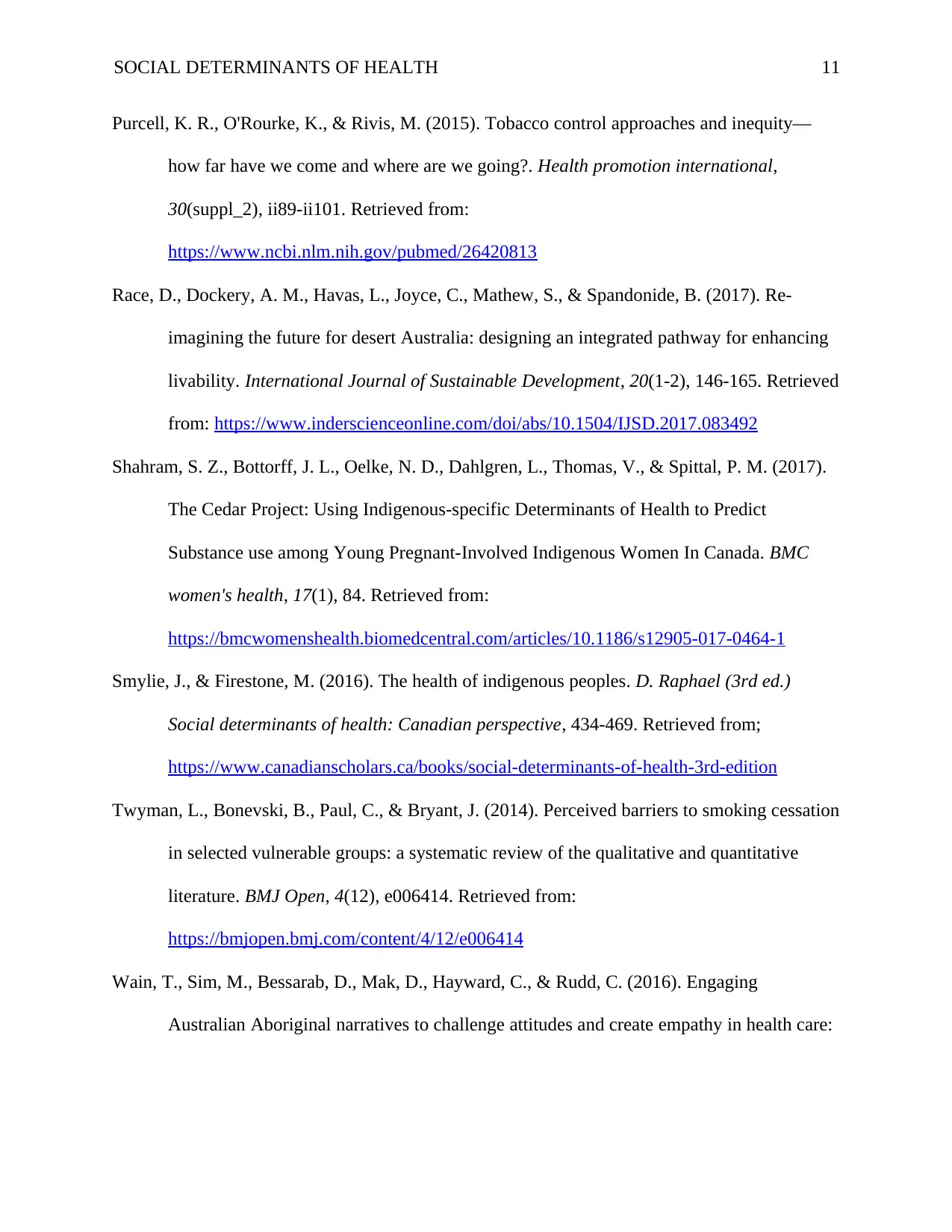
SOCIAL DETERMINANTS OF HEALTH 11
Purcell, K. R., O'Rourke, K., & Rivis, M. (2015). Tobacco control approaches and inequity—
how far have we come and where are we going?. Health promotion international,
30(suppl_2), ii89-ii101. Retrieved from:
https://www.ncbi.nlm.nih.gov/pubmed/26420813
Race, D., Dockery, A. M., Havas, L., Joyce, C., Mathew, S., & Spandonide, B. (2017). Re-
imagining the future for desert Australia: designing an integrated pathway for enhancing
livability. International Journal of Sustainable Development, 20(1-2), 146-165. Retrieved
from: https://www.inderscienceonline.com/doi/abs/10.1504/IJSD.2017.083492
Shahram, S. Z., Bottorff, J. L., Oelke, N. D., Dahlgren, L., Thomas, V., & Spittal, P. M. (2017).
The Cedar Project: Using Indigenous-specific Determinants of Health to Predict
Substance use among Young Pregnant-Involved Indigenous Women In Canada. BMC
women's health, 17(1), 84. Retrieved from:
https://bmcwomenshealth.biomedcentral.com/articles/10.1186/s12905-017-0464-1
Smylie, J., & Firestone, M. (2016). The health of indigenous peoples. D. Raphael (3rd ed.)
Social determinants of health: Canadian perspective, 434-469. Retrieved from;
https://www.canadianscholars.ca/books/social-determinants-of-health-3rd-edition
Twyman, L., Bonevski, B., Paul, C., & Bryant, J. (2014). Perceived barriers to smoking cessation
in selected vulnerable groups: a systematic review of the qualitative and quantitative
literature. BMJ Open, 4(12), e006414. Retrieved from:
https://bmjopen.bmj.com/content/4/12/e006414
Wain, T., Sim, M., Bessarab, D., Mak, D., Hayward, C., & Rudd, C. (2016). Engaging
Australian Aboriginal narratives to challenge attitudes and create empathy in health care:
Purcell, K. R., O'Rourke, K., & Rivis, M. (2015). Tobacco control approaches and inequity—
how far have we come and where are we going?. Health promotion international,
30(suppl_2), ii89-ii101. Retrieved from:
https://www.ncbi.nlm.nih.gov/pubmed/26420813
Race, D., Dockery, A. M., Havas, L., Joyce, C., Mathew, S., & Spandonide, B. (2017). Re-
imagining the future for desert Australia: designing an integrated pathway for enhancing
livability. International Journal of Sustainable Development, 20(1-2), 146-165. Retrieved
from: https://www.inderscienceonline.com/doi/abs/10.1504/IJSD.2017.083492
Shahram, S. Z., Bottorff, J. L., Oelke, N. D., Dahlgren, L., Thomas, V., & Spittal, P. M. (2017).
The Cedar Project: Using Indigenous-specific Determinants of Health to Predict
Substance use among Young Pregnant-Involved Indigenous Women In Canada. BMC
women's health, 17(1), 84. Retrieved from:
https://bmcwomenshealth.biomedcentral.com/articles/10.1186/s12905-017-0464-1
Smylie, J., & Firestone, M. (2016). The health of indigenous peoples. D. Raphael (3rd ed.)
Social determinants of health: Canadian perspective, 434-469. Retrieved from;
https://www.canadianscholars.ca/books/social-determinants-of-health-3rd-edition
Twyman, L., Bonevski, B., Paul, C., & Bryant, J. (2014). Perceived barriers to smoking cessation
in selected vulnerable groups: a systematic review of the qualitative and quantitative
literature. BMJ Open, 4(12), e006414. Retrieved from:
https://bmjopen.bmj.com/content/4/12/e006414
Wain, T., Sim, M., Bessarab, D., Mak, D., Hayward, C., & Rudd, C. (2016). Engaging
Australian Aboriginal narratives to challenge attitudes and create empathy in health care:
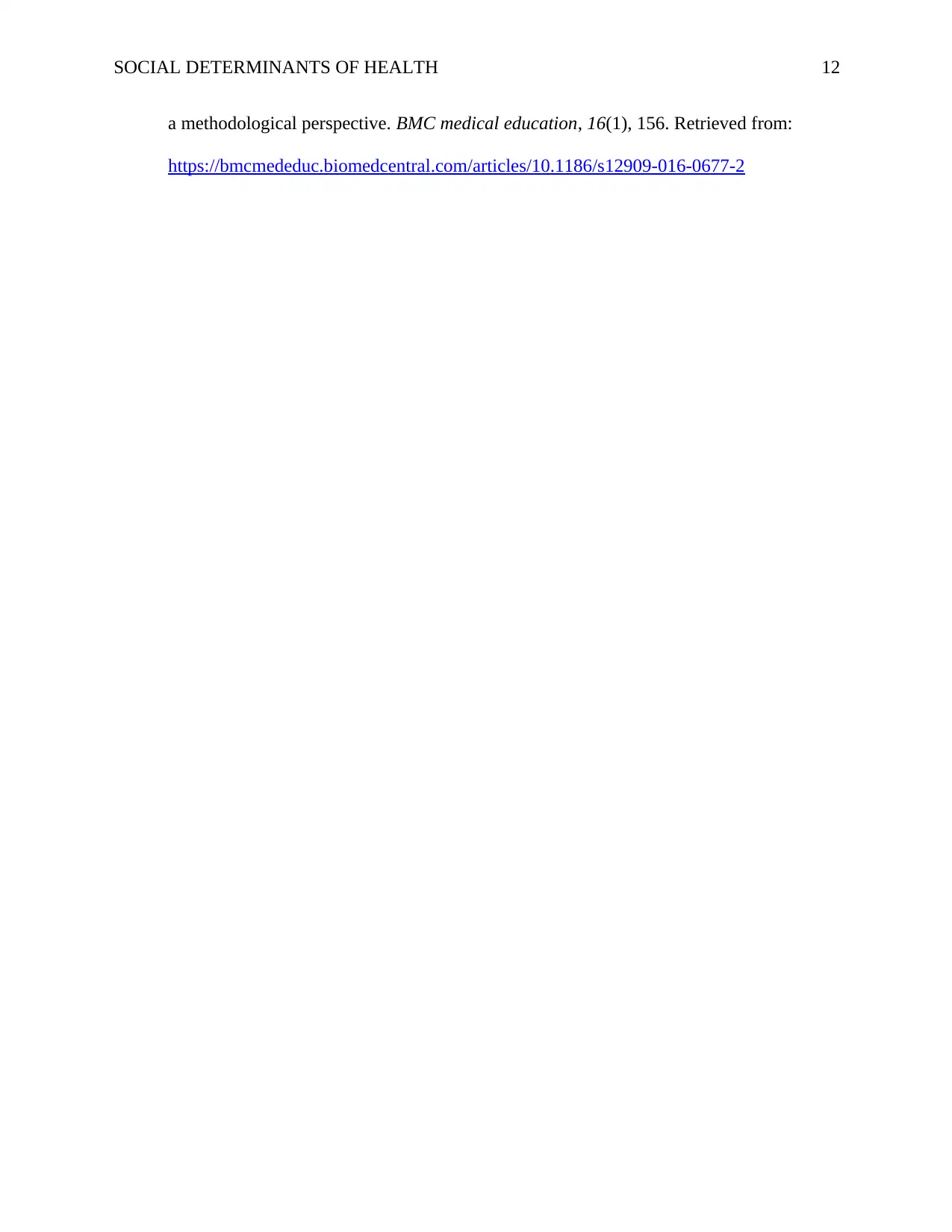
SOCIAL DETERMINANTS OF HEALTH 12
a methodological perspective. BMC medical education, 16(1), 156. Retrieved from:
https://bmcmededuc.biomedcentral.com/articles/10.1186/s12909-016-0677-2
a methodological perspective. BMC medical education, 16(1), 156. Retrieved from:
https://bmcmededuc.biomedcentral.com/articles/10.1186/s12909-016-0677-2
⊘ This is a preview!⊘
Do you want full access?
Subscribe today to unlock all pages.

Trusted by 1+ million students worldwide
1 out of 12
Related Documents
Your All-in-One AI-Powered Toolkit for Academic Success.
+13062052269
info@desklib.com
Available 24*7 on WhatsApp / Email
![[object Object]](/_next/static/media/star-bottom.7253800d.svg)
Unlock your academic potential
Copyright © 2020–2025 A2Z Services. All Rights Reserved. Developed and managed by ZUCOL.





